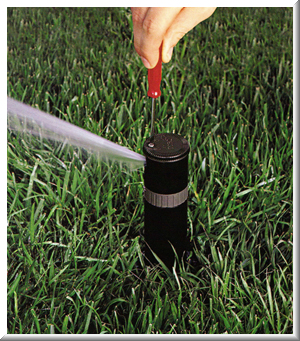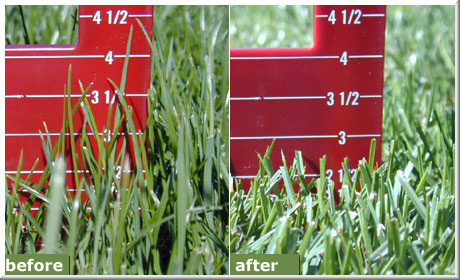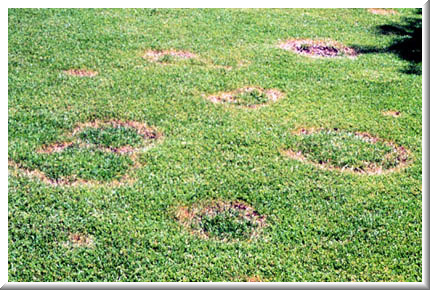Lawns
Lawn Care When the Temperatures Go Up
After the spring growing season, summer brings quite a bit of stress to lawns. Lawns that were lush and green in the spring now have to deal with less water, longer days, and more heat. While we all would love to keep the lushness of spring, lawns now require more care to stay healthy and green.
Most of the lawns in the Denver Metro Area are cool season grasses: bluegrass, ryegrass, and fescues. These grasses grow best when the temperatures are in the sixties to low seventies. While our evenings get down in those ranges, the intense heat and high altitude causes stress which needs to be countered by good maintenance practices.
Once temperatures get into the 80s and above, lawns begin to struggle, with cool season grasses having the hardest time. Growth will slow, color may fade, and lawns will show signs of wear and tear as they find it harder to recover from stress and traffic. It is not uncommon for improperly cared for cool season lawns to go dormant during the heat of the summer. When this happens they turn brown and stop growing.
If for some reason you are unable to water regularly, allow your lawn to go dormant. Do not water enough to green it up only to let it fade again. This does considerably more harm than simply letting it go (and stay) dormant. A dormant lawn will normally recover once cooler temperatures come back in the fall. The biggest concern for a dormant lawn is insects. A dormant lawn needs to be checked regularly for insect activity and damage since the damage is harder to spot than it is on a green lawn.
Water Properly
 Lawns need at least an inch and a half of water per week, and more when the heat is severe. Use a rain gauge or straight-sided can to keep track of the amount of water received from rainfall and irrigation.
Lawns need at least an inch and a half of water per week, and more when the heat is severe. Use a rain gauge or straight-sided can to keep track of the amount of water received from rainfall and irrigation.
♦Water deeply and less frequently to encourage drought-
tolerant roots.
♦Water early in the day to reduce evaporation and fungal growth.
Weed Control
Summer weeds and crabgrass can always be a problem and take vital nutrients and water away from the lawn. Getting and keeping the weeds under control can do a great deal to promote a healthy and happy lawn. Allowing professionals to apply weed control can prevent mistakes such as using the wrong type of weed killer. Also spraying in hot temperatures with the wrong products can cause damage to plantings not sprayed. Anyone spraying their own weeds needs to keep this in mind.
Mowing Tips
Raise your mower blade in the summer. Taller grass is more  drought-tolerant, grows deeper roots, and helps shade the earth to prevent weed seeds from germinating. Cool-season grasses should be mowed at 2½” – 3½” during the summer.
drought-tolerant, grows deeper roots, and helps shade the earth to prevent weed seeds from germinating. Cool-season grasses should be mowed at 2½” – 3½” during the summer.
Mow regularly, to prevent cutting more than ⅓ of the grass blade at a time. This keeps your grass healthier and prevents the clippings from smothering the grass.
Keep mower blades sharp. Make sure your mower is cutting your grass, not ripping the tips off, to minimize stress during hot temperatures. Also do not mow when the grass is wet. Mowing a dry lawn will prevent fungal spread and there will be less build-up of grass on the mower blades.
High-Traffic Areas
By summer, many lawns begin to show signs of wear and tear since we spend more time on our lawns. Dogs often follow the same patterns, so beaten down areas can quickly develop. In areas where there is constant traffic, it may be a good idea to install stepping stones to minimize damage to the lawn.
Finally, if your yard has gone dormant, try to minimize traffic to minimize damage to brittle grass blades. If you’re getting plenty of rainfall and your lawn is actively growing, proper fertilization can help keep it healthy.
Insects and Diseases
Dormant or drought-stressed lawns are more susceptible to insect infestations, such as chinch bugs, cutworms, billbugs, sod webworms, ants, and other pests. Minor infestations often take care of themselves, but severe problems require quick attention.
Summer also can bring about disease problems, such as leafspot, dollar spot, NRS, and Ascochyta. Fungicide applications may be needed in the worst cases. Things to avoid include night watering, and mowing with a dull mower
blade.




